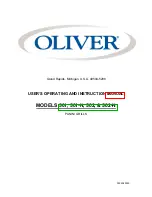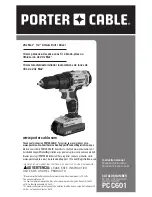
8 — English
OPERATION
NOTE:
When properly installed, the teeth on the depth stop
rod should be aligned with the teeth indicator on the depth
stop clamp.
Adjust the depth stop rod so that the drill bit extends
beyond the end of the rod to the required drilling depth.
When drilling holes with the depth stop rod installed, the
desired hole depth has been reached when the end of the
rod comes in contact with the surface of the workpiece.
MODE SELECTOR
See Figure 6, page 12.
The mode selector gives the operator three options.
NOTICE:
Never change modes while the tool is running. Failure
to obey this caution could result in serious damage to
the drill.
Rotational Drilling Mode
Drill bit rotation only; no hammering ac-
tion. Use for drilling and other heavy duty
applications.
Rotary Hammer Mode
Hammering action plus drill bit rotation.
Use for hammer drilling.
Chisel Only Mode
Hammering action only for chipping
concrete, tile, and masonry.
CHUCK ADAPTOR
(Not Included)
See Figure 7, page 12.
For drilling in metal, wood, and plastic with non-SDS Plus
drill bits, a chuck adaptor may be used.
NOTE:
Rotary hammer mode will damage the tool’s mech-
anism when used for fastening or drilling with non-SDS
Plus bits.
DRILLING/DRIVING SCREWS
Install the auxiliary handle.
Depress and release the switch trigger to be sure the drill
is in the
OFF
position before connecting it to a power
supply.
Check the direction of rotation selector for the correct
setting (forward or reverse).
Secure the material to be drilled in a vise or with clamps
to keep it from turning as the drill bit rotates.
Plug the drill into power supply.
NOTICE:
To prevent gear damage, always allow the chuck to
come to a complete stop before changing the direction
of rotation.
INSTALLING AND REMOVING SDS BITS
See Figures 4, page 12.
This tool is equipped with an SDS Plus connection system.
Unplug the drill.
Clean the bit and grease it with machine grease before
installing it into the chuck.
Insert the bit into the chuck.
Pull back the clamp collar and rotate the bit while pushing
it until it is inserted as far as possible into the chuck.
Pull on the bit to make sure it has locked into place.
To remove bits from the SDS Plus System:
Pull back the clamp collar and remove the bit.
NOTE:
When hammer drilling, use only bits with hard metal
and SDS Plus shaft.
USING THE AUXILIARY HANDLE ASSEMBLY
See Figure 5, page 12.
WARNING:
Always use the auxiliary handle when using this tool to
help resist torque reactions. Binding or stalling of this
product could lead to serious personal injury.
The drill is equipped with an auxiliary handle assembly. For
ease of operation, use the handle with either the left or
right hand. The handle can be rotated 360°.
To adjust the auxiliary handle assembly,
Loosen the handle assembly by turning the handle
counterclockwise.
Rotate the auxiliary handle assembly to the desired
operating position.
NOTE:
Make sure the notches on the inside of the aux-
iliary handle engage the tabs on the drill housing.
See
Figure 1 page 11.
Securely tighten by turning the auxiliary handle clockwise.
Be sure the auxiliary handle is securely tightened against
the depth stop clamp. This secures the depth stop rod
at the desired depth of cut. It also secures the auxiliary
handle.
NOTE:
For convenience and ease of starting threads, the
hex nut has been trapped inside the molded slot in the
auxiliary handle.
The depth stop rod helps control the depth of drilled holes.
Summary of Contents for SDS65
Page 31: ...13 NOTES NOTAS...









































